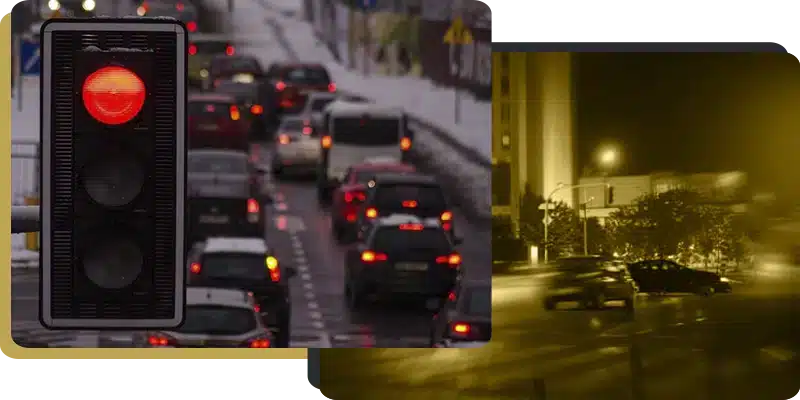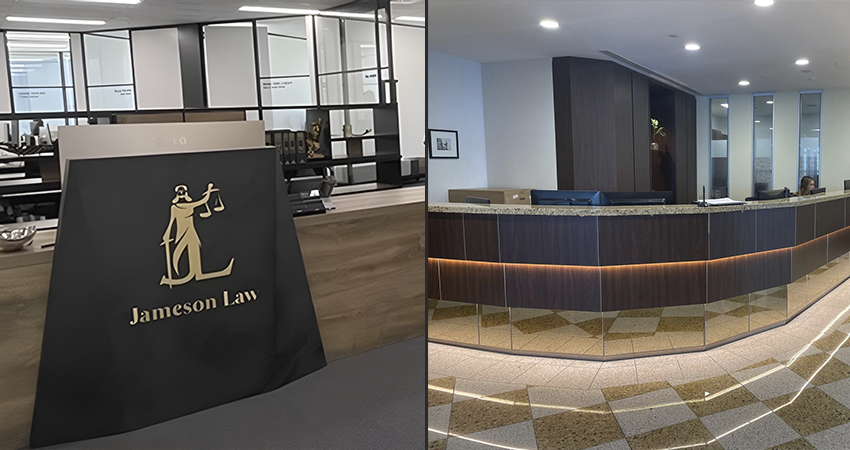BOOK YOUR CONSULTATION
This form submission is encrypted and secure.

OFFENSIVE LANGUAGE AND CONDUCT

Back to back winners of the most prestigious Local Business Awards and multiple criminal defence category awards.

Our criminal law knowledge and experience is your best defence.
Award Winning Criminal Law Experts
We have won several criminal defence and client service excellence awards every year up to and including 2025.
Proven Track Record
60+ Years of combined experience defending criminal matters means a successful outcome is on the table.
5 Star Reviews Everywhere
We’re in it to win it and we fight hard for our clients. That’s why anywhere you look you will find 5 star reviews.
Easy Finance Options
Get urgent premium legal representation now and pay later with affordable fortnightly or monthly payments.
Award Winning Criminal Law Experts
We have won several criminal defence and client service excellence awards every year up to and including 2025.
Proven Track
Record
60+ Years of combined experience defending criminal matters means a successful outcome is on the table.
5 Star Reviews
Everywhere
We’re in it to win it and we fight hard for our clients. That’s why anywhere you look you will find only 5 star reviews.
Easy Finance
Options
Get urgent premium legal representation now and pay later with affordable fortnightly or monthly payments.
Offensive language and offensive conduct are public order offences. They are a hotly debated topic across Australia as offensiveness is subjective. In Ball v McIntyre, the Supreme Court of the ACT recognised that what one person considers offensive, another person may not.
WE'RE IN IT TO WIN IT
Book your consultation
- This form submission is encrypted and secured to ensure your information remains confidential.
This form submission is encrypted and secured to ensure your information remains confidential.
What is offensive language and offensive conduct?
In New South Wales, offensive language and offensive conduct are covered under the offensive behaviour section of the Summary Offences Act 1988 (NSW) and the common law. Common law (case law) is law established through the courts interpretation of legislation, application of previous decisions, etc.
Offensive language and offensive conduct includes:
![]() Offensive conduct
Offensive conduct
![]() Offensive language
Offensive language
![]() Obscene exposure
Obscene exposure
![]() Obstructing traffic
Obstructing traffic
![]() Unauthorised entry of a vehicle or boat
Unauthorised entry of a vehicle or boat
![]() Damaging fountains
Damaging fountains
![]() Damaging or desecrating protected places
Damaging or desecrating protected places
![]() Climbing on or jumping from buildings and other structures
Climbing on or jumping from buildings and other structures
![]() Continuation of intoxicated and disorderly behaviour following move on direction
Continuation of intoxicated and disorderly behaviour following move on direction
![]() Possession of liquor by minors
Possession of liquor by minors
![]() Violent disorder
Violent disorder
Offensive language and offensive conduct offences are dealt with in the Local Court and prosecuted by Police Prosecutors not the DPP. However, for some offences, the Law Enforcement (Powers and Responsibilities) Act NSW (2002) gives Police power to issue penalty notices, also called a Criminal Infringement Notice (CIN). For matters dealt with by the Local Court, fines are based on penalty units set by the Summary Offences Act 1988 (NSW). Each penalty unit is worth $110. For example, 5 penalty units equal $550.
In a nutshell...
Offensive language and offensive conduct are minor criminal law offences that are dealt with by the Local Court. If you have been fined or charged by police, contact our office for a free initial consultation.

In a nutshell...
With no clear definition, you should seek legal advice from our expert criminal lawyers about defending charges or a fine.
Offensive language and offensive conduct defined
There is no clear definition of offensive language and offensive conduct even though the courts have attempted to establish a definition under common law. The standard of what constitutes offensive language and offensive conduct has changed over time and the common law has largely considered the offence in relation to the wounding of feelings, arousing anger, resentment, disgust or outrage in the mind of the reasonable person who has been exposed to that language or conduct. In other words, it looks to community standards. By today’s community standards, the words ‘fuck’, ‘fuck off’ and ‘cunt’ might be considered profanity by some, these ‘swear words’ are being slowly absorbed into everyday language as they have been accepted into popular culture and regularly appear in film and music. As a result, the courts are reluctant to enforce fines and charges for the use of these ‘expletives’ as they are usually made in the context of police dealings. NSW has similar offensive language laws as other states and has looked to the common law of states such as Victoria (Vic) and Queensland (QLD) to help establish a definition, however, no Australian state or territory has successfully resolved this issue. With no clear definition of offensiveness, many legal commentators such as McNamara and Quilter are advocating for the law to be repealed.What needs to be proven?
In Australia, the prosecution must prove all elements of an offence beyond reasonable doubt. The elements of each public order offence is outlined below. The courts also look to the mind of a reasonable person in the circumstances. A reasonable person is a hypothetical person who exercises average care, skill and judgment in their conduct. The reasonable person is considered to be contemporary, reasonably tolerant and thick-skinned. Part 11 of the Crimes Act states that when determining the mind of a reasonable person, self-induced intoxication can’t be taken into consideration. In He Kaw Te v The Queen, the High Court established that when you commit the act, you also need to have intent. Intent is proven if: You know the circumstances which make the doing of the act an offence, or You do not believe honestly and reasonably that the circumstances you are innocent. In other words, the prosecution must prove that you committed the act alleged and that you intended to commit the act, knowing that it was unlawful. When you have been arrested or fined by Police for offensive language or conduct during an interaction with them, the prosecution has difficulty meeting the required intention as it is difficult to prove that a reasonable person in the proximity would be offended by the behaviour or use of the word in the circumstances. It is not a defence to claim you lacked intention because you were intoxicated at the time of the offence.In a nutshell...
The prosecution must prove all elements of the offence beyond a reasonable doubt. It looks to what the reasonable person would or feel in the circumstance. Contact our criminal law experts for a free initial consultation about your matter.
Case Study
In Police v Butler, the accused, an intoxicated Aboriginal woman was summonsed to appear in the Local Court for offensive language. Police had been called to her residence due to complaints by her neighbours. During the interaction, she used the word fuck multiple times. The court held that the reasonable person, living near intoxicated persons, would not have been wounded, angered or outraged. The court held that community standards have changed and the court could not be satisfied beyond a reasonable doubt that the language was offensive.
Public order offences
Offensive conduct:
You must not conduct yourself in an offensive manner in or near, or within view or hearing of, a public place or a school. The police can issue Criminal Infringement Notice of $200. The maximum penalty for this offence is a fine of $660 or 3 months imprisonment. This offence does NOT include the use of offensive language. It is a defence if you can prove that you had a reasonable excuse for your behaviour. For example, a street brawl is considered offensive conduct, but self-defence or attempting to break up the brawl might be considered a defence.Case Study
In 2015, Sydney activist Danny Lim wore a sandwich board displaying the phrase ‘Tony you cun’t’. He was convicted of offensive conduct by the Local Court, however, the District Court upheld his appeal stating the appellant was making a political statement and had used the term as a play on words.
Offensive language:
You must not use offensive language in or near, or within hearing from a public place or school.
Police can issue a Criminal Infringement Notice of $150.
The maximum penalty for this offence is a fine of $660
Alternatives to a fine for this offence may include:
A community corrections order, or
Community service (for those under the age of 18).
The maximum number of community service hours the court can order for this offence is 100 hours.
It is a defence if you can prove that you had a reasonable excuse for your offensive language.
Case Study
John is walking down the street when he is stopped and questioned by two police officers. During his interaction with police, he tells the police officers to fuck off. The police charge him with multiple offences including offensive language under section 4a of the Summary Offences Act. While John’s language could be considered offensive to some, his language was directed at Police as a result of an interaction with them and the courts are unlikely to record a conviction.
Obscene Exposure:
You are not allowed to wilfully or obscenely expose yourself within the view of a public place or school.
The maxim penalty for this offence is a fine of $1,100 or 6 months imprisonment.
Case Study
Jack is driving from Sydney to Newcastle and has a sudden need to urinate. There are no public toilets close by so he pulls over and urinates on the side of the road. Jack does not intend to expose himself, so he uses common sense and stands behind a tree to avoid other members of the public from seeing him.

Obstructing Traffic:
You are not allowed to willfully prevent, in any manner, the free passage of a person, vehicle or vessel in a public place. The Police can issue a Criminal Infringement Notice of $200. It is a defence if you can prove that you had a reasonable excuse e.g. blocking traffic or pedestrian access due for safety reasons due to an accident.Unauthorised entry of vehicle or vessel
You cannot enter any vehicle or boat in a public place without the consent of the owner or legal occupier of the vehicle or boat. The Police can issue a Criminal Infringement Notice of $250. It is a defence if you can prove that you had a reasonable excuse. The maximum penalty for this offence is $440Damaging fountains
You cannot wilfully : Damage or deface, or Enter upon, or Cause any foreign material or substance to enter into, Any part of a fountain in a public place. The maximum penalty for this offence is a fine of $440.Case Study
Peter stops at the traffic lights and Sam approaches his vehicle, angry that Peter cut him off. As Sam reaches Peter’s vehicle, the traffic lights change. The traffic behind them is prevented from moving through the intersection while Sam argues with Peter about the incident. Concerned road users call the Police. Peter and Sam are both issued with a Criminal Infringement Notice of $200.
Damaging or desecrating protected places
You cannot willfully: Damage or deface any protected place The maximum penalty for this offence is a fine of $440. A protected place includes a shrine, or monument or statue in a public place, and includes a war memorial or internment site. You cannot commit any nuisance or offensive or indecent act in, or in connection with any war memorial or internment site. The maximum penalty for this offence is a fine of $2,200. A war memorial means: The Anzac Memorial in Hyde Park Sydney, or Another place within a public place that has been declared a war memorial, or A specified shrine, monument, statue or other structure or place within a specified are in the vicinity. An internment site means a place with a cemetery for the internment of human remains. It also includes a memorial. Instead of issuing a fine, the court has the discretion to issue a Community Corrections Order imposing community service.
Case Study
Sarah and James are visiting Hyde Park Sydney. They stop at a fountain and notice coins in the fountain. They decide to throw a coin in the fountain and ‘make a wish’. The coin is considered foreign material and both Sarah and James have committed a summary offence by tossing a coin in the fountain.
Climbing or jumping from buildings and other structures
If you: Abseil, jump or parachute from any part of a building or structure, or Climb down or up on or on otherwise descending or ascending any part of a building or other structure, except by use of the stairs, lift or other means provided for, You are guilty of an offence. The maximum penalty for this offence is a fine of $1,100, 3 months imprisonment or both. It is a defence if you have prove you had a reasonable excuse for committing the offence. For example, if you can prove you had a permit.Continuation of intoxicated and disorderly behaviour following a move on direction
If you: Are given a move on direction by a police officer for being intoxicated and disorderly in a public place, and You are intoxicated and disorderly in the same public place at any time within 6 hours of being given a move on direction, You are guilty of an offence. The police can issue a Criminal Infringement Notice of $200. The maximum penalty for this offence is a fine of $1,650. It is a defence if you can prove you had a reasonable excuse for breaching the move on direction.Case Study
Peter is a political activist. The day before Anzac Day, he throws red paint over his local war memorial to protest the war in Iraq. The red paint is symbolic of the lives of people who have died during the conflict. Peter has committed a summary offence by throwing red paint over the war memorial. While Peter is making a political statement, members of the public would be outraged over the desecration of the memorial, especially in lead up to Anzac Day. It is therefore unlikely Peter would escape conviction and would likely be required to pay a fine or be required to complete some form of community service.

Case Study
Greg climbed the Sydney Harbour Bridge without permission as a protest to his family court proceedings. This not only put his safety at risk, but it also risked the safety of other members of the public using the bridge. It also obstructed traffic using the bridge as the Police were required to close lanes due for safety reasons. He was issued a Criminal Infringement Notice (CIN) for obstructing traffic and was arrested by Police for climbing or jumping from buildings or other structures.
Possession of liquor by minors
If you are under 18 years of age and you posses or consume any liquor in a public place, you are guilty of an offence. The maximum penalty for this offence is a fine of $20. It is a defence if: You are under the supervision of a responsible adult, or You had a reasonable excuse for possessing or consuming liquor. For example, you were in possession of a bottle of wine to gift someone over the age of 18. A police officer can request you to provide your full name and address, and to produce documentary evidence e.g. a drivers licence, to prove you are over the age of 18. If you refuse, or provide false details, you are guilty of an offence. The maximum penalty for this offence is a fine of $20. A police officer may seize your liquor if they suspect on reasonable grounds that: You are under the age of 18, and You are not under the supervision of an adult, and You do not have a reasonable excuse for being in possession of the liquor.Case Study
Jack and Sam have been drinking at a pub in Parramatta. They have been at the pub for several hours and consumed a number of alcoholic beverages. They become very loud and security request them to leave the premises. They refuse to leave and security call the Police. The Police escort Jack and Sam from the property and given a move on direction. Half an hour later, Police are called to the same pub as Jack and Sam have attempted to re-enter. The Police have the discretion to issue a Criminal Infringement Notice of $200 each. However, if Jack and Sam still refuse to comply with the move on direction, the Police will arrest them and they will likely receive a criminal conviction resulting in a criminal record.
Violent Disorder
If you are in the company of two or more people, and you use or threaten to use unlawful violence and your conduct is such that it would cause a person of reasonable firmness present at the scene to fear for their personal safety, then each person using or threatening to use unlawful violence is guilty of an offence. The maximum penalty for this offence is a fine of $1,100 or 6 months imprisonment. This offence can take place either in private or a public place.Case Study
Sally and Jerry attend the New Years Eve fireworks on the Sydney foreshore. They are both under the age of 18 and are caught consuming alcohol by Police. The police officers ask Sally and Jerry for identification. They both refuse to provide identification. They are warned that failure to provide identification will result in them being arrested and taken back to the station to prove their identification. They eventually comply with the request and the police officers confirm they are under age. They also do not have adult supervision. The officers confiscate the alcohol and issue them both with a $20 fine.
Criminal Infringement Notices (CIN)
A Criminal Infringement Notice is a police issued on the spot fine for certain summary offences for certain summary offences. It was introduced after a review by the NSW Ombudsman into the dealings of Police where a caution or warning would have been more beneficial and cost-effective than criminal charges resulting in unnecessary contact with the criminal justice system. CINs were viewed as a positive step for Aboriginal people who come into contact with the Police, meeting the recommendations set out by the Royal Commission into Aboriginal Deaths in custody. However, it has resulted in an increase in the number of fines issued to Aboriginal people.
If you have been issued a CIN, you will have 21 days from the date it is issued to pay. There are a number of ways you can elect to pay your fine. They will be listed on the back of the fine.
If you don’t pay your fine on time, you will be sent a penalty reminder notice and given a further 28 days to pay your fine. If you fail to pay after that time, an enforcement order will be issued and you may be required to pay an additional $50 fee.
If you are issued with a CIN and pay the fine, you will not have a criminal record, however, your details will be retained on the COPS database.
You can appeal your CIN two ways:
![]() Apply to Revenue NSW to review your CIN:
Apply to Revenue NSW to review your CIN:
Revenue NSW will request NSW Police to conduct an internal review of the CIN as well as any supporting evidence.
![]() Elect to go to court:
Elect to go to court:
If you choose to appeal your CIN to the Local Court, you will need to notify Revenue NSW. You will then be issued with a Court Attendance Notice. A Court Attendance Notice will let you know what date, time and court your matter will be heard.
Your matter will be treated like other criminal offences. If you’re unsuccessful, you will be found guilty and will have a criminal conviction listed on your criminal record. You may also be required to pay additional court fees.
If you want to appeal your matter, you should have evidence to support your appeal. You should also contact our office for a free initial consultation.
If you elect to go to court, the court may and you are found guilty, the court issue you with a section 10.
A section 10 is the best possible outcome in the event the court finds you guilty of a larceny offence. There are three orders available to the court under section 10 of the Crimes (Sentencing and Procedure) Act where the court believes it is inappropriate to further punish an offender.
![]() Section 10 (1) (a)- dismissal with no conviction recorded
Section 10 (1) (a)- dismissal with no conviction recorded
![]() Section 10 (1) (b)- dismissal with no conviction on conditions set by the court. For example, not to commit an offence for a period of two years
Section 10 (1) (b)- dismissal with no conviction on conditions set by the court. For example, not to commit an offence for a period of two years
![]() Section 10 (1) (c)- dismissal with no conviction on the condition that the offender enters into an intervention program. For example drug and alcohol counselling.
Section 10 (1) (c)- dismissal with no conviction on the condition that the offender enters into an intervention program. For example drug and alcohol counselling.
A section 10 is an acknowledgement of the court that you have committed an offence, however, the court is satisfied that it is out of character and you are unlikely to continue offending. It’s the court’s way of giving you a second chance.
Before granting a section 10, the court will consider:
![]() Your criminal record.
Your criminal record.
![]() Your character, antecedents, age, heath and mental condition, etc
Your character, antecedents, age, heath and mental condition, etc
![]() The trivial nature of the offence
The trivial nature of the offence
![]() Extenuating circumstances that lead to the offence being committed
Extenuating circumstances that lead to the offence being committed
![]() Any other matter the court considers relevant
Any other matter the court considers relevant
Case Study
Megan and her friends attend a climate change protest in Sydney. As the protest progresses, some of the attendees become violent and start to damage property. Megan and her friends are arrested by Police for violent disorder and are summonsed to appear in the Local Court. The prosecution only needs to prove that Megan and her friends were in the company of two or more people and they used or threatened to use unlawful violence that would cause a person of reasonable firmness present at the scene to free for their safety. Megan needs to prove that while she was in the company of two or more persons, she did not use or threaten to use unlawful violence.
In a nutshell...
A police officer has the discretion to issue a criminal infringement notice (CIN) instead of arresting you for offensive language and offensive conduct. You can appeal a CIN to Revenue NSW or elect to go to court. Contact our office for expert criminal law advice and a free initial consultation.
The above is general legal information and should not be considered legal advice. You should speak with one of our criminal lawyers for legal advice tailored to your specific legal matter. The penalties listed are maximum penalties. The courts deal with matters on a case by case basis. It should also be noted that there may be court delays due to COVID-19.
Speak to an Expert Lawyer today

WE'RE IN IT TO WIN IT
Book your consultation
- This form submission is encrypted and secured to ensure your information remains confidential.
This form submission is encrypted and secured to ensure your information remains confidential.
What our Clients
Legal Answers ... In Short
Legislation: CRIMES ACT 1900
Section 195 - Destroying or damaging property
(1) A person who intentionally or recklessly destroys or damages property belonging to another or to that person and another is liable–
(a) to imprisonment for 5 years, or
(b) if the destruction or damage is caused by means of fire or explosives, to imprisonment for 10 years.
(1A) A person who, in the company of another person or persons, intentionally or recklessly destroys or damages property belonging to another or to that person and another is liable–
(a) to imprisonment for 6 years, or
(b) if the destruction or damage is caused by means of fire or explosives, to imprisonment for 11 years.
(2) A person who, during a public disorder, intentionally or recklessly destroys or damages property belonging to another or to that person and another is liable–
(a) to imprisonment for 7 years, or
(b) if the destruction or damage is caused by means of fire or explosives, to imprisonment for 12 years.
Section 196 - Destroying or damaging property with intent to injure a person
(1) A person who destroys or damages property, intending by the destruction or damage to cause bodily injury to another, is liable–
(a) to imprisonment for 7 years, or
(b) if the destruction or damage is caused by means of fire or explosives, to imprisonment for 14 years.
(2) A person who, during a public disorder, destroys or damages property, intending by the destruction or damage to cause bodily injury to another, is liable–
(a) to imprisonment for 9 years, or
(b) if the destruction or damage is caused by means of fire or explosives, to imprisonment for 16 years.
Section 197 - Dishonestly destroying or damaging property
(1) A person who dishonestly, with a view to making a gain for that person or another, destroys or damages property is liable–
(a) to imprisonment for 7 years, or
(b) if the destruction or damage is caused by means of fire or explosives, to imprisonment for 14 years.
(2) A person who, during a public disorder, dishonestly, with a view to making a gain for that person or another, destroys or damages property is liable–
(a) to imprisonment for 9 years, or
(b) if the destruction or damage is caused by means of fire or explosives, to imprisonment for 16 years.
Related Criminal Law News and Resources
Understanding our criminal law system can be tough. Here at Jameson Law, we understand that! That’s why we have written up this article
domestic violence matter resolved with a section 10 CRO without conviction This case study shows how our Sydney criminal defence
Privacy Issues in Criminal Cases in Australia Australia takes its privacy issues in criminal cases extremely seriously. These laws can
Charged with Domestic Violence – ‘Assault Occasioning Actual Bodily Harm’ Criminal Defence Lawyer finds serious issues in Prosecution’s case Nora
case outcome: release from custody and employment saved This case study highlights how our Sydney criminal defence team acts fast
Wollongong barcode shoplifting case: what happened In a bizarre yet surprisingly effective scheme, a 54 year old Wollongong man stole
AFP operation targeting ‘Ghost’ encrypted platform In a sweeping operation across multiple states, Australian Federal Police (AFP) have arrested the
The Facts behind the Common Assault Charge Our client, a middle-aged bank worker residing with her partner whom she had
FAQs
Frequently Asked Questions.
What is considered offensive language under NSW law?
Offensive language refers to words or expressions that are deemed inappropriate or abusive in public. Under the Summary Offences Act 1988 (NSW), using offensive language in or near a public place is a criminal offence. For tailored advice, consult a criminal lawyer in Sydney who understands how courts interpret such cases.
What are the penalties for offensive language and conduct?
Penalties can include fines, criminal convictions, or community service orders. According to the LawAccess NSW, fines can reach up to $660. If you are facing charges, reaching out to My Divorce Lawyers or Jameson Law can help you better understand your legal options.
Can a criminal record for offensive language affect my future?
Yes. A conviction for offensive language or conduct may appear on your criminal record, potentially impacting your employment and travel opportunities. Learn more about criminal records from the Service NSW portal, or seek guidance from experienced criminal defence solicitors in Sydney.
Can the police arrest me for swearing in public?
Yes, police have the power to issue on-the-spot fines or arrests in certain circumstances. However, whether the language qualifies as “offensive” is often subjective. If you feel your rights were breached, you can seek help from the NSW Ombudsman or book a consultation with Jameson Law solicitors.
How can a lawyer help me with an offensive language charge?
A lawyer can negotiate with prosecutors, challenge the evidence, and help avoid a criminal conviction. At Jameson Law, our team has extensive experience in defending clients facing public order offences. For additional resources, see the NSW Law Reform Commission and the Australian Attorney-General’s Department.
WE'RE IN IT TO WIN IT
Book your consultation
- This form submission is encrypted and secured to ensure your information remains confidential.
This form submission is encrypted and secured to ensure your information remains confidential.
Our SYDNEY Offices
Parramatta CBD - Head Office
- (02) 8806 0866
- 0488 817 882
- 02 9052 0840
- info@jamesonlaw.com.au
- Suite 301, 67-69 Philip St Parramatta NSW 2150
Sydney CBD - Practice Office
- 02-8806-0866
- 0488 817 882
- 02 9052 0840
- info@jamesonlaw.com.au
- Tower One Barangaroo International Towers Level 35, 100 Barangaroo Ave Sydney NSW 2000
Blacktown CBD - Practice Office
- (02) 8806 0866
- 0488 817 882
- 02 9052 0840
- info@jamesonlaw.com.au
-
Level 3 81 Flushcombe Road, Blacktown NSW 2148
(By Appointment Only)

Liverpool CBD - Practice Office
- (02) 8806 0866
- 0488 817 882
- 02 9052 0840
- info@jamesonlaw.com.au
-
Level 2, 215-219 George Street, Liverpool NSW 2170
(By Appointment Only)

Bankstown CBD - Practice Office
- (02) 8806 0866
- 0488 817 882
- 02 9052 0840
- info@jamesonlaw.com.au
-
23 Restwell Street, Bankstown NSW 2200
(By Appointment Only)



